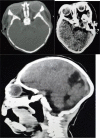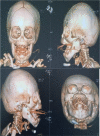Congenital complete arhinia with alobar holoprosencephaly
- PMID: 37449001
- PMCID: PMC10336630
- DOI: 10.4314/gmj.v56i3.14
Congenital complete arhinia with alobar holoprosencephaly
Abstract
Congenital arhinia is a life-threatening, rare craniofacial disorder, which, when not identified and managed early can cause severe respiratory distress at birth due to upper airway obstruction. Since neonates are obligate nasal breathers, simultaneous sucking and breathing requirement in neonates with arhinia leads to respiratory distress. Inspiration and expiration through the oral passage alone may result in thoracic retraction, thereby further exacerbating respiratory distress. We report a rare case of congenital complete arhinia with alobar holoprosencephaly in a 9-month-old. With no family history of congenital malformations, maternal risk factors and uneventful pregnancy, a term female neonate was delivered vaginally without immediate post-delivery respiratory distress. Examination revealed microcephaly, absent fontanelles, fused cranial sutures and bilateral microphthalmia. Breathing was spontaneous, with no immediate signs of respiratory distress. An additional diagnosis of alobar holoprosencephaly was made after a head computed tomography (CT) scan was done. Management included the initial stabilisation phase of supplemental oxygen and an orogastric tube for feeding. The baby did not require both tracheostomy and gastrostomy tubes, as she was not in severe respiratory distress requiring a tracheostomy tube nor having difficulties feeding with the orogastric tube.
Keywords: Arhinia; Respiratory Distress; holoprosencephaly.
Copyright © The Author(s).
Conflict of interest statement
Conflict of interest: None declared
Figures



References
-
- Blair Vilray Papin, Brown James Barrett. “Nasal abnormalities, fancied and real: The reaction of the patient: Their attempted correction.”. International Journal of Orthodontia, Oral Surgery and Radiography. 1932;18(4):363–401.
-
- Gordon Christopher T, Xue Shifeng, Yigit Goekhan, Filali Hicham, Chen Kelan, Rosin Nadine, Yoshiura Kohichiro, et al. “De novo mutations in SMCHD1 cause Bosma arhinia microphthalmia syndrome and abrogate nasal development.”. Nature genetics. 2017;49(2):249–255. - PubMed
-
- Leroy D, Slachmuylder E, Popijn M, Cassart M, Massez A, D'Haene N, Désir J, et al. “Antenatal Diagnosis of Isolated Total Arhinia in the Second Trimester of Pregnancy.”. Open Journal of Obstetrics and Gynecology. 2016;6(07):419.
Publication types
MeSH terms
Supplementary concepts
LinkOut - more resources
Full Text Sources
